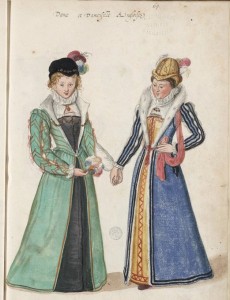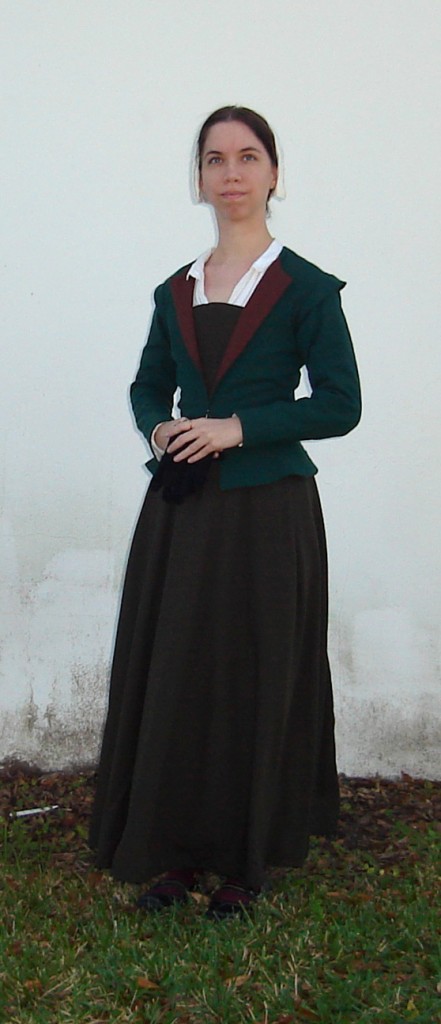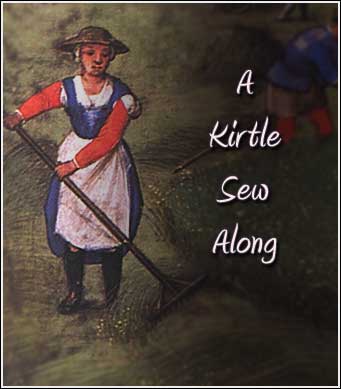Sewing in the lining around the top edge
Clipping into corners and trimming
Edge stitching the seam allowance to the lining along the top
Sewing in the lining around the top edge
Clipping into corners and trimming
Edge stitching the seam allowance to the lining along the top
Pleating the skirt down with knife pleats and a box pleat in the back
Basting the pleats in place
Ironing the pleats down to keep things from moving around when I sew the skirt to the bodice

It has been 3 or 4 (mumble) years since I was going to do the kirtle sew-along. Life, family medical issues and changes got in the way. My skill set has improved, how I break down projects has improved, but that does not mean I’m not still learning.
So I set up the video camera, I balanced my tripod on the printer that-may-work-but-I-really-just-use-it-as-a-scanner, shoved my social anxiety into a box and hit record.
I’m making kirtles. I’m making several kirtles that I plan to donate to Much Ado about Sebastopol. I don’t think I will get them all done in time for this years run, but there is always next year. If they get used, or auctioned off in a fundraiser, or end up in a school theater closet that is fine.
I have several yards of wool, pattern blocks, and a chunk of time to make something out of it all.
The playlist: https://www.youtube.com/watch?v=LTne9pSn75A&list=PL-5opaHvhlOkbr8K8buX1OpZm_4kHPPgU
The first three videos:

I’m in need of a new underskirt or petticoat for my 16th century clothing. I’ve been using the same cotton broadcloth one I made back in 2005, for years now. It is serviceable, but it adds a lot of bulk at the waist and it isn’t very authentic in construction or materials.
So it is time to for a new one.
I have 3.5 yards of a lovely wine colored, lightweight worsted wool donated to me by Noel. (Thank you Noel! <3 )
I’ll be drafting the pattern on the fabric and hand sewing the whole thing with linen thread.
I’m working from the Spanish version of Alcega’s Book. The english translation is out-of-print and painfully expensive. I’m not a native nor fluent spanish speaker so google and a few other resources will be heavily used.
I’m using the translated chart of symbols from the tailors book into modern inches from the Curious Frau’s site.
Taking some inspiration from Other Andrew’s The Alcega Project.
And keeping in mind the information of the Modern Maker has posted about his study of the patterns on his blog and on the Elizabethan Costume Facebook group.
Definition from “Nuevo diccionario portatil, espanol e ingles: compuesto segun los mejore…“
Manteo: s, m : a church man’s cloke; a woman’s under petticoat.
Language is a fluid thing, always changing. The above definition is from 1728 far later than the 16th century. However even later dictionaries simply list it as a cloak or mantle. Context is key, when it is listed as Manteo de Muger, chances are it is a skirt.

I managed to sneak in a little bit of hand sewing this past week.

It’s done, it’s done!
I finished the full Elizabethan ensemble (it does need some ruffs but that is for another day) for my friend’s birthday/Gift-mas/every other holiday in the world for the next 300 years. I am now going to sleep the sleep of the dead.
So starting with the bottom layers:
Linen/cotton blend shirt with reinforced french seams. Cranberry wool skirt with tucked hem, a pocket and fingerloop braided closing.

I finally finished off the jacket project I started a few months ago. Well, I guess I really started it when I made the scaling up patterns video. I didn’t make any huge changes to the pattern I scaled up, the measurements were close to mine and I wanted to see what I would end up with. I had this green wool in my stash for a few years now and I knew that was what it wanted to be. It then fought me every step of the way. This was going to be a nice soothing hand sewing project that I could take my time on and enjoy. That lasted for a few weeks until I realized I needed to unpick both sleeves and sleeve lining. I decided it could either sit in the corner until it behaved or I could switch to the sewing machine and get it done.
Done is good, done is a wonderful thing.

So this is partly hand sewn, partly machine sewn with some hand finishing. In hindsight I should have done one more mock-up of the pattern to get everything super perfect but its a jacket and it works as a jacket.
The only changes I did to the pattern was to accommodate my ski slope shoulders and take the back seams in, and then take the back seams in even more, and raise the neckline to not quite doublet height.
Looking at it now I should let the back seams out a wee bit, I don’t have hooks and eyes in yet so there is some puckering where I pinned it shut. The only other change I might do is bring the armscye forward a little bit more.
The extra poof at the back of the sleeve lets me reach forward and up and back with no horrible pulling.
(more…)

So I posted about this on Facebook and on the Renn. costume forum but forgot to post about it here. Opps.
I’ve made a lot of kirtles, in various ways, with various materials and stiffening. I’ve also answered a lot of questions about kirtles, and while I will be the first to tell you I’m not the end all be all fount of kirtle information, I have learned a great deal about them.
I’ve decided to host a kirtle sew along, and go step by step on how I make a basic 16th century kirtle. This will help people just starting out, middle of the road sewers and maybe the experts will pick up a few tricks. I’m going to be posting in a mixture of photos, written instructions and if the weather cooperates, video.
I’m not going to hand sew this one, I tend to use the sewing machine where it will not show and hand finish the parts that will.
I’m giving a rough idea in the amounts listed if you are taller than average or plan to heavily preshrink your fabrics add more yardage.
4 to 5 yards of wool
4 to 5 yards linen for lining or just 2 yards of linen if only lining the bodice and sleeves
1 to 2 yards of twill/drill/canvas for interlining
2 to 4 yards muslin/calico for flatlining and mock ups
Matching embrodiery thread for eyelets
A roll of paper for patterning, or newspaper can work in a pinch..
Tracing wheel
Awl
Chalk
Hand sewing needles, pins and so forth.
Lacing strips for fitting.
After much debate, I decided to use a store bought pattern as a base. Not everyone has a fitted bodice block, nor does everyone have access to a printer to print one out, or a dress form for draping.
Simplicity 3723 and 2354 is a basic costume pattern in a good range of sizes, the “Pilgrim” dress has waist darts and bust darts but no other fancy shaping so it is ideal for adapting. And in the U.S. with Halloween coming up they usually put the patterns on sale.
I’ll cover rotating out the darts, adapting the pattern to a curved front bodice, trouble shoot any fitting issues as best I can and any other things that might come up.
I haven’t worked with commercial patterns for a long time so this will be a refresher course for me.
We will be ignoring the pattern instructions, if you have a similar pattern in your stash, feel free to use it instead.